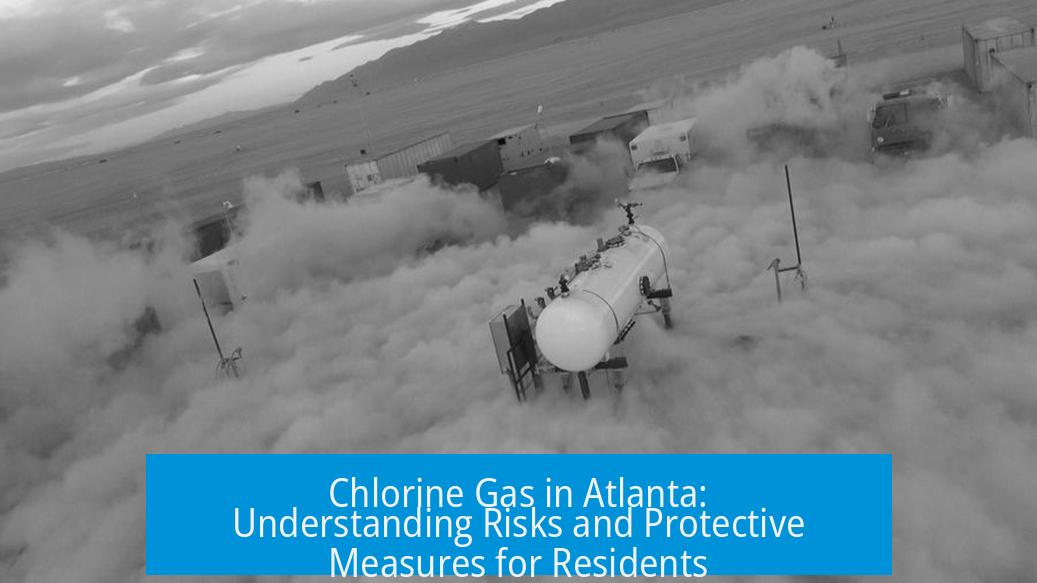How Worried Should Residents of Atlanta, GA Be Over Undisclosed Amounts of Chlorine Gas Pouring Into Our Atmosphere?
Residents of Atlanta, GA should maintain cautious vigilance but not panic regarding the undisclosed chlorine gas releases. Chlorine reacts quickly with environmental factors and dissipates in hours, limiting long-term atmospheric persistence. Acute irritation symptoms appear at moderate levels, but chronic health effects are linked to prolonged high exposure, which remains uncertain due to limited data. Protective actions, ongoing monitoring, and awareness are prudent until the situation stabilizes.
Understanding Chlorine Gas Chemistry and Atmospheric Behavior
Chlorine gas is highly reactive, especially when it contacts water. This reaction produces hydrochloric acid, which irritates mucous membranes. Even very low chlorine concentrations can cause a burning sensation in the nose, signaling exposure.
Due to this reactivity, chlorine gas does not hang around in the air long. It typically persists from 30 minutes to a few hours depending on the amount and environmental conditions. Sunlight further accelerates its breakdown.
- Chlorine is heavier than air, so it tends to stay near the ground and not travel far.
- It reacts with moisture, surfaces, and organic material rapidly, limiting its atmospheric life.
- Therefore, chlorine disperses and neutralizes relatively quickly after release.
Implications for Residents
The short atmospheric lifespan means exposure tends to be localized and time-limited. However, repeated or continuous releases could lead to cumulative exposure concerns.
Health Effects of Chlorine Gas Exposure
Acute Health Impacts
Immediate contact with moderate to high chlorine levels causes respiratory irritation. Symptoms include:
- Sore throat
- Burning eyes
- Coughing
- Nasal irritation
At sufficiently high concentrations, chlorine can lead to lung inflammation similar to pneumonia, which may require emergency care if breathing difficulties develop after the gas dissipates.
Long-Term and Chronic Exposure Risks
Chronic health risks emerge primarily with prolonged exposure at concentrations over regulatory limits. The Occupational Safety and Health Administration (OSHA) sets an 8-hour maximum exposure limit for chlorine gas at 0.5 parts per million (ppm).
- Brief or intermittent exposure below these limits usually results in reversible effects.
- People with respiratory issues such as asthma may experience worsened symptoms at lower levels.
Dose-Dependent Effects Table
| Exposure Level | Likely Health Effects |
|---|---|
| Below 0.1 ppm | Minor irritation or no symptoms |
| 0.1 – 0.5 ppm | Mild irritation of respiratory tract and eyes |
| Above 0.5 ppm over 8 hours | Potential for chronic respiratory issues |
| High concentrations (short-term) | Moderate to severe lung injury and irritation |
Environmental Impact of Chlorine Gas Releases
Locally, chlorine gas harms ecosystems by damaging vegetation and aquatic life. Fish kills and other visible signs of harm may occur near the release site.
However, the overall environmental threat is largely localized and transient due to rapid chlorine breakdown.
Residents should not rely on foraged food from nearby areas affected by chlorine.
Protective Measures for Atlanta Residents
Immediate Steps to Reduce Exposure
- Evacuate contaminated areas if possible until chlorine gas concentrations diminish.
- Keep HVAC systems off to prevent indoor infiltration.
- Seal doors and windows using duct tape or similar materials to minimize air exchange.
- Limit outdoor activities when chlorine odors or symptoms occur.
- Regularly wash exposed skin and clothing to remove residues.
- Stay hydrated by drinking plenty of water.
Considerations for Indoor Air Quality
Chlorine gas is heavier than air, so it may accumulate near ground level in enclosed spaces without ventilation. Proper ventilation after a chlorine incident is crucial once outside air quality improves.
Time as a Factor
The threat decreases over time as chlorine disperses. Reducing time spent in affected areas reduces risk.
Data Gaps and Ongoing Uncertainty
The most pressing issue for Atlanta residents is the lack of comprehensive information on the amount and concentration of chlorine gas released.
- Publicly available emission data for the facility involved is limited or outdated.
- Continuous releases related to cleanup efforts are ongoing, complicating risk assessment.
- Real-time chlorine monitoring is available through environmental agencies but may not cover all affected regions.
Residents are encouraged to check resources like the EPA’s chlorine monitoring sites online (https://r7data.response.epa.gov/PublicViper/BioLabERChlorine/).
Monitoring wind patterns is also critical, as they influence gas dispersion and the areas affected.
Additional Chemical Concerns
There is speculation that bromine might be involved in the incident. Bromine shares similar sensory properties to chlorine but has higher toxicity.
This raises the potential for more severe health effects if exposure occurs.
Community Reports and Symptoms
Residents across Atlanta and neighboring regions report chlorine-like odors and related symptoms:
- Eye irritation and respiratory discomfort
- Bleaching odors reminiscent of pool chlorine
- Symptoms extending as far away as Tampa and Roswell
These reports emphasize the need for public health awareness and responsive communication from authorities.
Key Takeaways
- Chlorine gas is highly reactive and transient, reducing atmospheric persistence but causing immediate irritation at moderate levels.
- Acute exposure generally causes reversible irritation; chronic effects require longer exposure at regulatory limit exceedances.
- Environmental damage is local and short-term; the public should avoid foraging near affected areas.
- Residents should take simple protective actions including evacuation, sealing homes, and minimizing outdoor activity during releases.
- Lack of complete data on release volumes and concentrations limits precise risk assessment.
- Continuous monitoring and following official advisories are essential as cleanup operations may cause ongoing emissions.
- Potential involvement of other toxic chemicals such as bromine could heighten health risks.
- Community symptoms and odors reported across wide areas highlight exposure concerns and the need for vigilance.





Leave a Comment